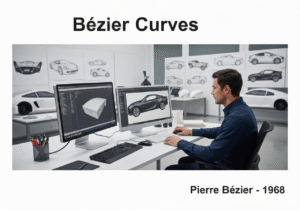This is our latest selection of worldwide publications and patents in english on Augmented Reality (AR), between many scientific online journals, classified and focused on augmented reality, mixed reality, computer vision, haptic feedback, AR headset, marker-based tracking, wearable AR, interactive experience and immersive technology.
Enhancing 3D Monocular Object Detection with Style Transfer for Nighttime Data Augmentation
Published on 2025-10-21 by Alexandre Evain, Firas Jendoubi, Redouane Khemmar, Sofiane Ahmedali, Mathieu Orzalesi @MDPI
Abstract: Monocular 3D object detection (Mono3D) is essential for autonomous driving and augmented reality, yet its performance degrades significantly at night due to the scarcity of annotated nighttime data. In this paper, we investigate the use of style transfer for nighttime data augmentation and evaluate its effect on individual components of 3D detection. Using CycleGAN, we generated synthetic night images from daytime scenes in the nuScenes dataset and trained a modular Mono3D detector under differe[...]
Our summary: This study explores using style transfer for augmenting nighttime data in monocular 3D object detection. Synthetic night images generated from daytime scenes improved certain detection metrics but degraded others. Combining style transfer with real nighttime data enhances detection robustness under low-light conditions.
3D Object Detection, Style Transfer, Data Augmentation, CycleGAN
Publication
SDN 06 Taluak IV Suku)
Published on 2025-10-20 by Zainatul Sirti, Neny Rosmawarni, Musthofa Galih Prada, Nunik Destria Arianti, Novita Widyaningrum @MDPI
Abstract: The solar system is a Basic Competency for grade VI students at SDN 06 Taluak IV Suku. This material encourages students to recognize planets and their characteristics in the solar system, thus requiring interactive learning media. This research develops solar system flashcard learning media based on AR technology to enhance learning interactivity. Using the MDLC method, the application was built with Unity Editor and Vuforia SDK for Android and iOS devices. The application utilizes marker-based[...]
Our summary: This research develops an AR-based flashcard application for teaching the solar system to grade VI students. The application features 3D models of planets and includes interactive quizzes for evaluation. Testing confirms its effectiveness in enhancing learning interactivity and engagement.
AR technology, interactive learning, 3D models, educational flashcards
Publication
A Method for Defect Inspection of Power Transmission Lines
Published on 2025-10-20 by Jianing Chen, Xin Zhang, Dawei Feng, Jiahao Li, Liang Zhu @MDPI
Abstract: Unmanned Aerial Vehicle (UAV)-based computer vision has emerged as a crucial approach for transmission line defect detection. However, transmission lines contain multi-scale components in complex environments, thereby complicating the accurate extraction of multi-scale features and necessitating a careful balance between model complexity with detection accuracy. This paper proposes a Transformer-based framework called Power Line Defect Detection Transformer (PLD-DETR). To simultaneously capture [...]
Our summary: This paper presents a Transformer-based framework called PLD-DETR for defect detection in power transmission lines using UAVs. It introduces a dual-domain selection mechanism for collaborative feature extraction and an adaptive sparse self-attention mechanism to enhance critical feature processing. Experimental results show significant improvements in detection accuracy and efficiency compared to baseline models and other methods.
UAV, defect detection, Transformer, feature extraction
Publication
Hybrid Convolutional Transformer with Dynamic Prompting for Adaptive Image Restoration
Published on 2025-10-19 by Jinmei Zhang, Guorong Chen, Junliang Yang, Qingru Zhang, Shaofeng Liu, Weijie Zhang @MDPI
Abstract: High-quality image restoration (IR) is a fundamental task in computer vision, aiming to recover a clear image from its degraded version. Prevailing methods typically employ a static inference pipeline, neglecting the spatial variability of image content and degradation, which makes it difficult for them to adaptively handle complex and diverse restoration scenarios. To address this issue, we propose a novel adaptive image restoration framework named Hybrid Convolutional Transformer with Dynamic [...]
Our summary: The Hybrid Convolutional Transformer with Dynamic Prompting (HCTDP) is designed for adaptive image restoration. It introduces a Spatially Aware Dynamic Prompt Head Attention module for local restoration and a Gated Skip-Connection module for feature refinement. The framework shows superior performance in various restoration tasks while using fewer parameters than competitors.
Hybrid Convolutional Transformer, Dynamic Prompting, Image Restoration, Spatially Aware Attention
Publication
Hybrid Regularized Variational Minimization Method to Promote Visual Perception for Intelligent Surface Vehicles Under Hazy Weather Condition
Published on 2025-10-17 by Peizheng Li, Dayong Qiao, Caofei Luo, Desong Wan, Guilian Li @MDPI
Abstract: Intelligent surface vehicles, including unmanned surface vehicles (USVs) and autonomous surface vehicles (ASVs), have gained significant attention from both academic and industrial communities. However, shipboard maritime images captured under hazy weather conditions inevitably suffer from a blurred, distorted appearance. Low-quality maritime images can lead to negative effects on high-level computer vision tasks, such as object detection, recognition and tracking, etc. To avoid the negative inf[...]
Our summary: This work presents a novel method to enhance visual perception for intelligent surface vehicles operating in hazy conditions. It introduces a transmission map estimation and refinement framework to generate haze-free maritime images. Comprehensive experiments demonstrate that the proposed method outperforms existing dehazing techniques, improving navigation safety.
Variational Minimization, Visual Perception, Haze Removal, Intelligent Surface Vehicles
Publication
A Lightweight Self-Supervised Monocular Depth Estimation Framework with Multi-Scale Feature Extraction
Published on 2025-10-16 by Xinxing Tian, Zhilin He, Yawei Zhang, Fengkai Liu, Tianhao Gu @MDPI
Abstract: Monocular depth estimation is an essential component in computer vision that enables 3D scene understanding, with critical applications in autonomous driving and augmented reality. This paper proposes a lightweight self-supervised framework from single RGB images for multi-scale feature extraction and artifact elimination in monocular depth estimation (MsGf). The proposed framework first designs a Cross-Dimensional Multi-scale Feature Extraction (CDMs) module. The CDMs module combines parallel m[...]
Our summary: This paper presents a lightweight self-supervised framework for monocular depth estimation using multi-scale feature extraction. It introduces a Cross-Dimensional Multi-scale Feature Extraction module and a Sobel Edge Perception-Guided Filtering module to enhance feature representation and reduce artifacts. Experimental results show that the proposed method outperforms state-of-the-art techniques while maintaining a low parameter count.
Monocular Depth Estimation, Self-Supervised Learning, Multi-Scale Feature Extraction, Artifact Suppression
Publication
System and method for policy-constrained symbolic rendering of ai outputs
Patent published on the 2025-09-18 in US under Ref US2025294061 by ONESOURCE SOLUTIONS INT INC [US] (Arkoff Harold [us], Jukic Vedran [it])
Abstract: A computer-implemented system and method are provided for policy-constrained symbolic rendering of artificial intelligence (AI) outputs in regulated, high-stakes environments. The invention transforms conventional machine-generated inference outputs into semantically compressed symbolic glyphs, each visually encoding not only the inference result, but also the associated policy, provenance, user role, jurisdiction, and legal status. The system comprises a rendering controller that evaluates AI o[...]
Our summary: The system transforms AI outputs into symbolic glyphs that encode inference results and associated policies. It evaluates display eligibility based on real-time rules and user context, rendering approved glyphs while suppressing or substituting denied outputs. The architecture ensures lawful interaction with AI, enhancing trust and reducing cognitive load.
policy-constrained, symbolic rendering, AI outputs, compliance
Patent
Cybersecurity architectures for multi-contextual risk quantification
Patent published on the 2025-09-18 in US under Ref US2025294047 by QRSHIELD LLC [US] (Brown Joseph [us], Rodriguez Anthony [us])
Abstract: The present disclosure relates to cybersecurity architectures and systems for assessing and quantifying security threats and risks associated with machine-readable codes, such as quick response codes, barcodes, data matrix codes, and other types of codes. A security application comprises a multi-context threat assessment system configured to analyze a broad spectrum of risk assessment attributes across multiple contexts. These contexts relate to the machine-readable code itself, target network r[...]
Our summary: The disclosure presents cybersecurity architectures for quantifying risks related to machine-readable codes. It features a multi-context threat assessment system analyzing various risk attributes. Additionally, it includes an API for integration and an AI-powered network for enhanced threat detection.
Cybersecurity, Risk Assessment, Machine-Readable Codes, AI-Powered Systems
Patent























